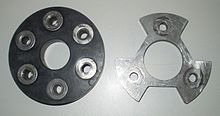Hardy disk

The hardy disk (flexible disk), also known as the Giubo coupling or Giubo coupling , is a disk usually made of rubber or another elastic material with mostly vulcanized metal bushings , which in cardan shafts ( cardan shafts ) ensure that the two axes are slightly offset and even minimal misalignments are compensated and at the same time torque shocks are dampened, which occur when the speed is changed or the shaft starts up .
Use restrictions
In contrast to the functionally similar universal joint , Hardy disks can only be used if there is hardly any angular misalignment and misalignments to be compensated for. A hardy disc that is twisted all around would be destroyed in a very short time by internal heat from flexing . An angular misalignment of up to 3 degrees is permissible for flexible disks with a fabric insert, and even less for hardy disks made of pure rubber because the torque is only transmitted via the elastomer .
Origin of name
The name Hardyscheibe, which is mainly used in German, goes back to the Englishman John Leslie Hardy, who through his company Hardy Spicer & CO Ltd. had the design registered in 1938 as the inventor at the Royal Patent Office in Great Britain under number GB497903. In English, the disc is usually only referred to as "flexible joint disc", "flex disc" or "rag joint".
The name Giubo is etymologically a contraction of the Italian word giunto ('joint', 'connection' or 'coupling') and the surname of the engineer who invented and patented it, Antonio Boschi. Later he founded GIUBO SpA to manufacture flexible joint discs.
Areas of application
Hardy disks are traditionally used in the drive technology of automobiles; Their typical application is at the transmission output of vehicles with rear-wheel drive , e.g. B. at BMW and Mercedes-Benz . Hardy disks are used for all rotating shafts in industry and agriculture. These are decoupled from vibrations and spared from hard knocks, which is why attachments can be designed with smaller dimensions. Examples are combine harvesters , tractors , forklifts and vibration dampers in the drive train of engine test benches . Ship drives can also be equipped with Hardy disks, which are then correctly referred to as link joint disks . Another application of the Hardy disc can also be found in the steering between the steering wheel and the steering gear.
Assembly method
The Hardy disk is mounted by screwing the bushes to the shafts to be connected, whereby one bushing is alternately connected to the drive shaft and another bushing to the output shaft to ensure that the forces pass through the elastic disk.
Special forms
There are also Hardy discs without bushings vulcanized into them. They are not screwed on, but just plugged between the journal washers. Because of the centrifugal force , however, in most cases a metal ring is pushed over the rubber element (hardy disk) on the outside. The cardan drive at the gearbox output of BMW motorcycles from the 1950s and 1960s is an example of this: BMW R 25/3 , BMW R 26 , BMW R 27 . As of 2008, the Irbiter motorcycle factory was the only manufacturer that still used Hardy discs in its model range.
See also
Web links
- Patent GB497903 : Flexible coupling discs. Published December 30, 1938 Applicant: Hardy Spicer & CO LTD; John Leslie Hardy; Frank Allan Middleton.
Individual evidence
- ^ Giubo pronunciation and word origin. Alfa Romeo Owners' Club digest, June 17, 2003, accessed December 15, 2014 .


